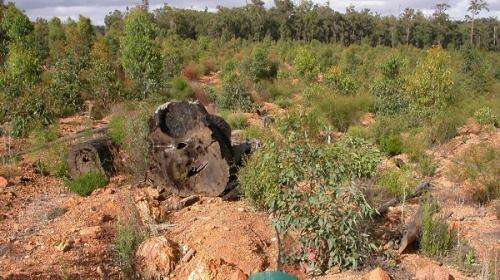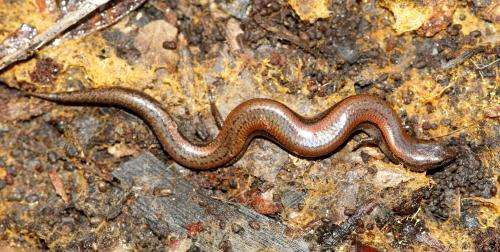A restored mine site. Credit: Michael Craig
In order for reptiles and mammals to successfully recolonise rehabilitated mine sites an improvement in coarse woody debris (CWD) use for restoration is needed, local research suggests.
Consisting of log and woody vegetation of varying sizes, CWD has been used in forest rehabilitation for decades, yet little research had been done to assess its impact on vertebrae species in restored mine sites.
This led Murdoch University, UWA and Alcoa to sample species from bauxite mine-pits restored three-years ago and surrounding forest near Dwellingup.
Researchers assessed early trends in CWD-related recolonisation, finding limited success.
While frog populations were consistent, reptile and mammal recovery were not.
"Reptile communities differed significantly between unmined and restored sites, and both overall reptile abundance and reptile species richness were significantly greater in unmined forest," Murdoch expert Dr Michael Craig says.
Several species were abundant in natural forest but completely absent from three-year old restored mine sites, including the common south-west ctenotus (Ctenotus labilladieri), south-western crevice skink (Egernia napoleonis) and south-western earless skink (Hemiergis initialis).
Mammal populations showed similar deviations.
south-western earless skink (Hemiergis initialis). Credit: ron_n_beth
The house mouse (Mus musculus) was abundant in three-year old restored areas, but absent in natural nearby forest, while the opposite was true for the shrew-like marsupial the yellow-footed antechinus (Antechinus flavipes), or 'mardo'.
"The provision of CWD did reduce barriers and accelerate recolonisation for some species, but overall, the effects were not strong," Dr Craig says.
"Restored forests were primarily inhabited by species that did not require CWD."
The report says this could be due to spatial arrangements and the density of CWD, which is distributed as 'habitat piles' at an average of 1.8 per hectare.
Dr Craig says using more clumped logs instead of scattering is likely to increase biodiversity, and that 50 logs per hectare would better reflect natural home ranges for species such as the south-western crevice skink.
A greater concern is the long-term management of sites.
While restored CWD is likely to be burnt by control burns and wildfires within 75 years, replanted jarrah and marri trees are unlikely to produce sufficient CWD on their own until they are over 200 years old.
Dr Craig says planning for this gap is vital.
"The management of restored forest will need to accelerate the growth of suitably-sized trees and return a proportion of that tree growth as CWD to the forest floor by either killing or felling branches or whole trees," he says.
More information: Michael D. Craig, Andrew H. Grigg, Richard J. Hobbs, Giles E. St. J. Hardy, "Does coarse woody debris density and volume influence the terrestrial vertebrate community in restored bauxite mines?", Forest Ecology and Management, Volume 318, 15 April 2014, Pages 142-150, ISSN 0378-1127, dx.doi.org/10.1016/j.foreco.2014.01.011.
Journal information: Forest Ecology and Management
Provided by Science Network WA























